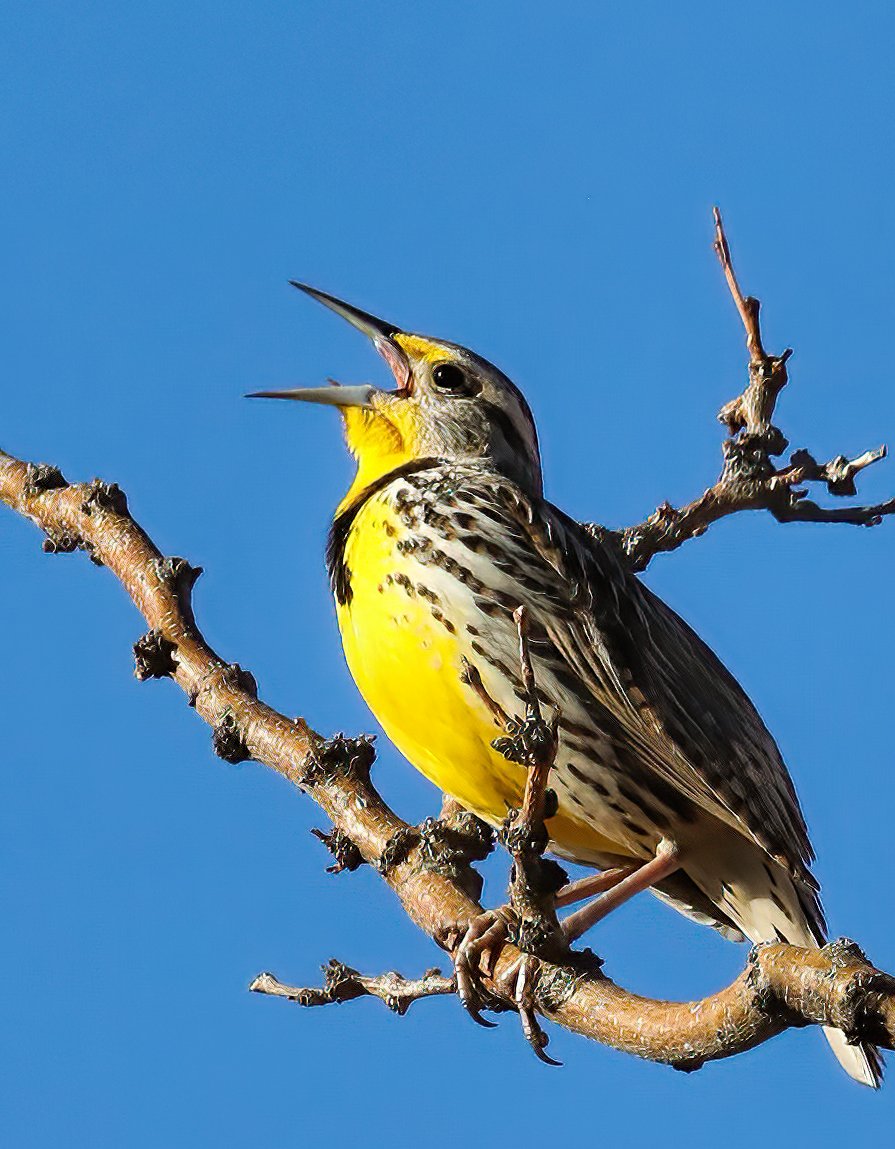are visiting my winter oasis, as many as six on the ground simultaneously, pecking around for bird seed.
Well camouflaged Western Meadowlark (Sturnella neglecta).
are visiting my winter oasis, as many as six on the ground simultaneously, pecking around for bird seed.


Well camouflaged Western Meadowlark (Sturnella neglecta).
of a trachyte porphyry from the La Sal Mountain laccolith (Eocene) showing euhedral orthoclase phenocrysts 1-4 cm long.

The dark phenocryst in the center of the image shows clear zoning. The groundmass consists of orthoclase with minor plagioclase, biotite, hornblende and augite.
have seen me out on my RadRover 5 nearly every day the last couple of weeks, and I snapped this panorama at the midpoint of my 17.5 mile ride today (~1,600 feet vertical). Always fun and enjoyable.
Click on image to embiggen.
heralds the beginning of a new day.

Western Meadowlark (Sturnella neglecta).

with Apex Expeditions, having just been asked to co-lead a two-week long itinerary exploring Iceland in the spring. Volcanoes and glaciers and stunning landscapes!


Here’s a full description of the tour: Apex Expeditions - Iceland in Spring 2022.
having now dried out from a wet spell in January.

at Boca Chica, Texas, also known as Starbase, where SpaceX has stacked the largest and most powerful rocket for an orbital test launch in the coming months. The booster and Starship seen here is taller than the Saturn V that heaved Apollo to the Moon, with more than twice the thrust and 100-150 tons of payload capacity. WOW.
Image credit: NASASpaceflight.com (click on image to enlarge).
Elon Musk is determined to make humans a multi-planetary species, and this is the launch system that will take us to the Moon and Mars. Learn more about Starship here.
a Western Meadowlark (Sturnella neglecta) melodically claiming its territory with song.


Note the translucent nictitating membrane covering the eye in this image, the equivalent of a “blink.”
chase a soaring raptor overhead this afternoon. This Red-tailed Hawk (Buteo jamaicensis) is being abused by several pesky Western Ravens (Corvus corax sinuatus) in the images below.



overwhelmed the feeding station this afternoon, with more than 50 in number. Here are just a few.


Pinyon Jay (Gymnorhinus cyanocephalus).
by this pint-sized Northern Shrike. It’s quite the regular hunter at the feeding station these days but very difficult to photograph.

Northern Shrike (Lanius borealis) relaxing après-kill.
strolling along on a dusky walk.

Mule deer (Odocoileus hemionus).
for mass wasting events in the canyons. A local resident shares the image below, taken last night on UT 128, about a mile north of Dewey Bridge. It’s the geology of now!

Image credit: Cathy Sherwood.
of Starlings is swarming about the valley. Just don’t look up with your mouth open.



above the eastern skyline late this afternoon, the first full orb of the new year.


UPDATE: Tonight’s moonrise, Sunday, 16 January, shown below.

parking lot prankster. These huge and handsome and intelligent birds are highly entertaining and loads of fun to watch.

Western Raven (Corvus corax sinuatus).

Pro tip: Shoot these active characters near a dumpster!
for the hawk to lift and carry away, this raiding rodent is pigging out daily on bird seed. The cheek pouches appear to be at capacity in the image below.
Well fed rock squirrel (Otospermophilus variegatus). Click on image to embiggen.
is in the neighborhood, successfully grabbing a bird at the feeding station for brunch, but much too quickly for me to capture the kill. This poor image was taken shortly afterwards, in dim and drizzly conditions.

Immature Northern Shrike (Lanius borealis).
of the death of Sir Ernest Shackleton.
On the evening of 4 January 1922, as his ship - the Quest - lay anchored in the Grytviken harbor on South Georgia, he wrote his final thoughts in his diary: "A wonderful evening. In the darkening twilight I saw a lone star hover, gem like above the bay." Sadly, later that night, he succumbed to a heart attack and died in the place he loved most. RIP.
I used an astronomical charting program to determine, for that night in North Cumberland Bay on South Georgia, the star he likely saw was either Sirius or Canopus, the two brightest stars in the evening sky.

on the Colorado River.
